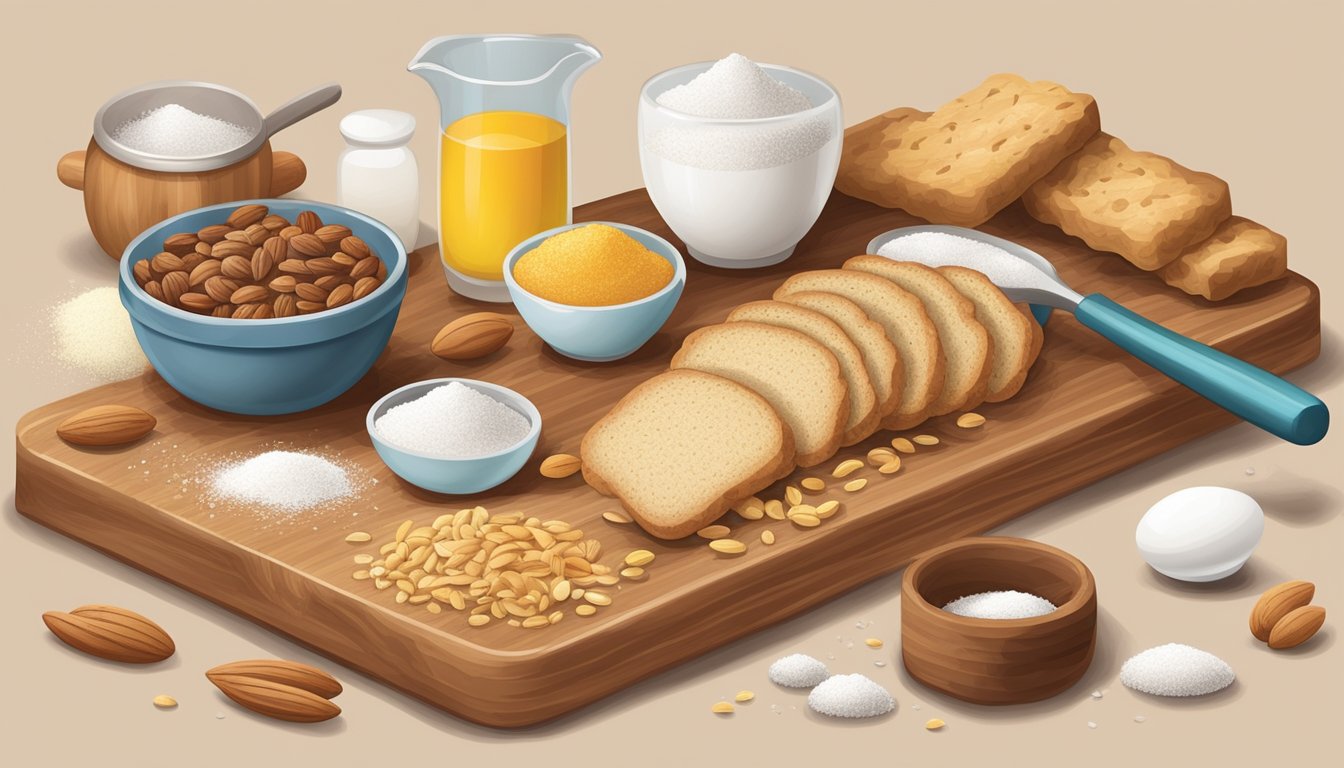Biscotti, the classic Italian twice-baked cookies, make for a delightful homemade breakfast treat. These crunchy, flavorful treats pair perfectly with coffee or tea to start the day. Making breakfast biscotti at home is easier than many people realize, requiring just a few simple ingredients and some basic baking techniques.
The process involves creating a dough, shaping it into logs, baking once, slicing, and then baking again to achieve the signature crisp texture. Homemade biscotti allow for customization with various mix-ins like nuts, dried fruits, or chocolate chips. Traditional flavors often include almond or anise, but creative bakers can experiment with different extracts, zests, and spices.
While store-bought versions are readily available, making biscotti from scratch provides a fresher taste and the satisfaction of creating something by hand. The aroma of freshly baked biscotti filling the kitchen is an added bonus to this rewarding culinary experience.
Understanding Biscotti
Biscotti are iconic Italian cookies known for their distinctive shape and crunchy texture. These twice-baked treats have a rich history and unique characteristics that set them apart from other baked goods.
History of Biscotti
Biscotti originated in the Tuscan region of Italy during the Roman era. The name comes from the Latin “bis coctus,” meaning “twice cooked.” Roman soldiers carried these long-lasting cookies on long journeys due to their extended shelf life.
In the 14th century, biscotti reemerged in Tuscany as cantucci. These almond-studded cookies became popular accompaniments to the local dessert wine, Vin Santo. Over time, biscotti spread throughout Italy and eventually gained worldwide popularity.
Today, traditional Italian biscotti remain true to their roots, while variations have emerged to suit different tastes and cultures.
Characteristics of Biscotti
Biscotti are distinguished by their oblong shape and dry, crunchy texture. Classic Italian biscotti are typically:
- Twice-baked for extra crispness
- Made without butter or oil
- Flavored with nuts, particularly almonds
- Less sweet than many modern cookies
The dough is first baked as a log, then sliced and baked again. This process creates their signature crunch and low moisture content. Traditional biscotti are perfect for dunking in coffee, tea, or sweet wine.
Modern variations may include chocolate chips, dried fruit, or different nuts. Some recipes incorporate butter for a softer texture, though purists prefer the authentic crunch of traditional biscotti.
Essential Ingredients
Crafting the perfect breakfast biscotti requires careful selection of key ingredients. Quality components and proper ratios are crucial for achieving the ideal texture and flavor profile.
Choosing Quality Flour
All-purpose flour forms the base of most biscotti recipes. Its protein content provides structure and contributes to the characteristic crunch. For best results, use unbleached flour from reputable brands.
Some bakers experiment with alternative flours like whole wheat or almond flour to add nutritional value or unique flavors. These substitutions may alter texture, so adjust liquid content accordingly.
When measuring flour, use the spoon-and-level method for accuracy. Sift the flour to remove lumps and incorporate air, resulting in a lighter biscotti.
Types of Sugars and Sweeteners
Granulated white sugar is the standard sweetener in biscotti recipes. It provides sweetness and helps create a crisp texture. Brown sugar can be used for a richer flavor and softer texture.
Natural sweeteners like honey or maple syrup add distinct flavors. When using liquid sweeteners, reduce other liquid ingredients to maintain proper dough consistency.
Some recipes incorporate both granulated sugar and honey for a balance of sweetness and texture. Experiment with different combinations to find your preferred taste profile.
Eggs: The Binding Agents
Eggs play a crucial role in biscotti, acting as binders and providing structure. They contribute to the dough’s elasticity and help create the signature crisp texture.
Use large eggs at room temperature for best results. This ensures even distribution throughout the dough. For richer biscotti, some recipes call for extra egg yolks.
Egg wash, made from beaten egg and water, can be brushed on the dough before baking. This creates a golden, shiny surface on the finished biscotti.
Leavening Agents and Their Role
Baking powder is the primary leavening agent in biscotti. It creates small air pockets, giving the cookies their characteristic light and crisp texture.
Use double-acting baking powder for best results. This type activates both when mixed with wet ingredients and when exposed to heat.
Some recipes include a small amount of salt. While not a leavening agent, salt enhances flavors and balances sweetness.
• Typical amount: 1-2 teaspoons baking powder per 2 cups flour
• Salt: ¼-½ teaspoon per recipe
Fats in Biscotti
Traditional biscotti recipes use minimal fat, but modern variations often include butter or oil. Fats contribute to flavor and affect texture.
Butter adds richness and a tender crumb. Use unsalted butter to control salt content. Soften butter before mixing for even distribution.
Olive oil is sometimes used in place of butter, especially in savory biscotti. It imparts a subtle fruity flavor and keeps the cookies crisp for longer.
For flavor enhancement, many recipes include vanilla extract or almond extract. These aromatics complement the nuts and fruits often found in biscotti.
Lemon zest adds bright notes to sweet biscotti. Use organic lemons and grate only the outer yellow peel for best flavor.
Flavoring Your Biscotti

Biscotti offer a versatile canvas for flavor experimentation. From nuts and fruits to chocolate and spices, the possibilities for customizing these Italian cookies are nearly endless.
Nuts and Their Textures
Almonds are a classic choice for biscotti, providing both flavor and crunch. Chopped almonds or walnuts can be folded into the dough before baking. For a softer texture, use finely ground nuts.
Pistachios add a unique color and subtle sweetness. Toast nuts lightly before adding to enhance their flavor.
Consider experimenting with hazelnuts or pecans for different taste profiles. Aim for about 1/2 to 3/4 cup of chopped nuts per batch of biscotti.
Incorporating Dried Fruit
Dried cranberries offer tartness and chewiness to contrast the crisp texture of biscotti. Chop larger dried fruits like apricots or figs into smaller pieces for even distribution.
Dried cherries pair well with chocolate-flavored biscotti. Raisins or currants can add natural sweetness without overpowering other flavors.
Soak dried fruit in warm water or liqueur for 10-15 minutes before adding to the dough. This prevents them from drawing moisture from the biscotti during baking.
Using Chocolate and Cocoa
Cocoa powder can be incorporated into the dough for all-over chocolate flavor. Replace about 1/4 cup of flour with cocoa powder in your recipe.
Chocolate chips mixed into the dough create pockets of melted chocolate. Use mini chips for more even distribution.
Dip or drizzle cooled biscotti with melted chocolate for an elegant finish. Dark, milk, or white chocolate can be used based on preference.
Exploring Extracts and Zests
Vanilla extract is a common addition to biscotti dough, enhancing overall flavor. Almond extract complements nut-based biscotti recipes.
Anise extract provides a traditional Italian flavor profile. Start with 1/4 to 1/2 teaspoon and adjust to taste.
Orange or lemon zest adds bright, citrusy notes. Use about 1 tablespoon of zest per batch. Combine zest with granulated sugar before mixing into the dough for better distribution.
Adding Spices and Herbs
Cinnamon is a popular spice for biscotti, especially in fall and winter recipes. Start with 1 teaspoon per batch and adjust as desired.
Cardamom pairs well with citrus flavors in biscotti. Use ground ginger for a warm, spicy note.
Dried herbs like rosemary or lavender can create unique savory-sweet combinations. Use sparingly, about 1/2 to 1 teaspoon per batch, as their flavors can be intense.
Mix spices with dry ingredients before combining with wet ingredients to ensure even distribution throughout the dough.
Baking Techniques
Mastering the art of biscotti baking requires attention to detail and specific techniques. From properly mixing the dough to achieving the perfect crisp texture, each step plays a crucial role in creating delicious homemade biscotti.
Mixing and Kneading Dough
Start by combining dry ingredients in a large bowl. In a separate bowl, whisk together wet ingredients. Gradually add the wet mixture to the dry, stirring until a shaggy dough forms.
Turn the dough onto a lightly floured surface. Knead gently for 1-2 minutes until smooth. Avoid overworking the dough, as this can result in tough biscotti.
For extra flavor, fold in nuts, dried fruit, or chocolate chips at this stage. The dough should be firm but pliable.
Shaping the Dough
Divide the biscotti dough into two equal portions. On a lightly greased baking sheet, shape each portion into a log about 12 inches long and 2 inches wide.
Flatten the logs slightly with your hands. Space them at least 3 inches apart on the baking sheet to allow for spreading during baking.
For uniform biscotti, use a ruler to measure and mark the logs before shaping. This ensures consistent size and baking.
Baking to Achieve Crispness
Bake the shaped logs in a preheated oven at 350°F (175°C) for 25-30 minutes. The logs should be lightly golden and firm to the touch.
Remove from the oven and let cool for 10 minutes. Reduce oven temperature to 325°F (165°C).
Using a sharp knife, cut the logs diagonally into 1/2-inch slices. Place slices cut-side down on the baking sheet.
Return to the oven for 10-15 minutes, then flip and bake for another 10-15 minutes. This second baking dries out the biscotti, creating their signature crisp texture.
Cooling and Storage
Allow biscotti to cool completely on a wire rack. This step is crucial for achieving maximum crispness.
Once cooled, store biscotti in an airtight container at room temperature. They will stay fresh for up to 2 weeks.
For longer storage, place biscotti in a freezer-safe container with parchment paper between layers. Frozen biscotti can last up to 3 months.
To refresh stored biscotti, place them in a 300°F (150°C) oven for 5-10 minutes. This restores their crispness and enhances their flavor.
Pairing and Serving

Biscotti’s versatility shines through its ability to complement various drinks and occasions. Its crunchy texture and subtle sweetness make it a perfect companion for both casual and sophisticated settings.
Biscotti as a Breakfast Treat
Biscotti serves as an excellent breakfast option, offering a light yet satisfying start to the day. Its crisp texture pairs wonderfully with morning coffee, providing a delightful crunch when dunked. For a quick breakfast, serve biscotti alongside fresh fruit or yogurt.
Some enjoy spreading a thin layer of butter or jam on their biscotti for added flavor. Health-conscious individuals may opt for whole grain or nut-studded varieties to increase nutritional value.
Biscotti with Beverages
Biscotti’s firm texture makes it ideal for dunking in various hot beverages. It pairs exceptionally well with:
- Espresso or cappuccino
- Hot chocolate
- Tea (both black and herbal varieties)
For a refreshing twist, try serving biscotti with iced coffee or cold brew in warmer months. The biscotti’s ability to maintain its structure when dunked makes it a favorite among coffee and tea enthusiasts.
Biscotti as a Dessert Complement
Beyond breakfast and beverages, biscotti shines as a versatile dessert option. It can be served:
- Alongside a scoop of gelato or ice cream
- With dessert wines like Vin Santo
- As part of a dessert platter with fresh fruits and cheese
For an elegant touch, drizzle melted chocolate over biscotti or serve it with a chocolate dipping sauce. Biscotti’s neutral sweetness allows it to complement both rich and light desserts without overpowering them.
Variations of Biscotti
Biscotti offer endless possibilities for flavor combinations and creative twists. From classic almond to indulgent chocolate and fruit-studded varieties, there’s a biscotti recipe to suit every taste preference.
Almond Biscotti Variations
Traditional almond biscotti remain a popular choice. Add slivered almonds to the dough for extra crunch. Incorporate almond extract or amaretto liqueur to intensify the almond flavor.
For a nutty twist, try substituting part of the flour with almond meal. This creates a more tender texture while boosting the almond taste. Dip one end of the baked biscotti in melted white chocolate and sprinkle with crushed almonds for an elegant finish.
Chocolate-Based Biscotti
Chocolate lovers can indulge in cocoa-infused biscotti. Replace some of the flour with cocoa powder for a rich chocolate base. Mix in chocolate chips or chunks for double chocolate goodness.
For a mocha flavor, add instant espresso powder to the dough. Drizzle cooled biscotti with melted dark chocolate or white chocolate for contrast. Experiment with different types of chocolate – milk, semi-sweet, or bittersweet – to find your perfect blend.
Fruit and Nut Combinations
Dried fruits and nuts add texture and flavor to biscotti. Popular combinations include:
- Cranberry and pistachio
- Fig and walnut
- Cherry and almond
- Apricot and pecan
Chop dried fruits into small pieces for even distribution. Toast nuts before adding to enhance their flavor. Citrus zest, like orange or lemon, complements many fruit and nut pairings.
Unique and Experimental Flavors
Push biscotti boundaries with unexpected flavors. Try savory options like rosemary and olive oil or sun-dried tomato and basil. For sweet variations, consider:
- Matcha green tea
- Lavender and honey
- Pumpkin spice
- Maple pecan
Incorporate spices like cardamom, ginger, or cinnamon for warmth. Use extracts like coconut or maple to create distinct flavors. Don’t be afraid to mix sweet and savory elements for a surprising twist on traditional biscotti.
Tips for Perfect Biscotti
Mastering biscotti requires attention to detail and proper technique. These tips will help you achieve crisp, flavorful cookies every time.
Measuring Ingredients Accurately
Precise measurements are crucial for successful biscotti. Use a kitchen scale for dry ingredients like flour and sugar. This ensures consistency in texture and flavor.
Level off measuring cups with a straight edge for accuracy. Spoon flour into the cup rather than scooping directly from the container.
For wet ingredients, use clear measuring cups at eye level. Add liquids gradually to avoid overfilling.
Measure small amounts of baking powder and salt with proper measuring spoons. Level them off for precision.
Timing and Temperature Considerations
Preheat the oven to 350°F (175°C) before mixing ingredients. This allows for even baking from the start.
Bake the initial log for 30-35 minutes until lightly golden. Let it cool for 10 minutes before slicing.
For the second bake, reduce oven temperature to 325°F (165°C). This prevents over-browning while achieving desired crispness.
Bake sliced biscotti for 5-7 minutes on each side. Watch closely to avoid burning.
Allow biscotti to cool completely on a wire rack before storing or serving.
Slicing Techniques for Consistency
Use a sharp, serrated knife for clean cuts. A dull blade can cause crumbling.
Wait until the baked log is slightly cooled but still warm. This prevents excessive crumbling during slicing.
Cut at a 45-degree angle for traditional biscotti shape. Aim for slices about 1/2 inch thick.
Apply gentle, even pressure while sawing through the log. Avoid pressing down too hard.
For uniform size, mark the log with light scoring before slicing.
Storing Biscotti for Freshness
Cool biscotti completely before storage to prevent moisture buildup.
Store in an airtight container at room temperature. This maintains crispness and prevents staleness.
Add a slice of bread to the container to absorb excess moisture if needed.
Biscotti can last up to 2 weeks when stored properly.
For longer storage, freeze biscotti in airtight bags for up to 3 months. Thaw at room temperature before serving.
Avoid refrigerating biscotti, as this can introduce unwanted moisture.
Troubleshooting Common Issues

Biscotti-making can present challenges, but with a few simple techniques, you can overcome them. Here are solutions to frequent problems encountered when baking these Italian treats.
Crumbly Biscotti Fix
Crumbly biscotti can result from overmixing or using too much flour. To fix this, reduce mixing time and measure flour carefully. Add an extra egg or a tablespoon of milk to the dough if it seems dry.
For better texture, let the dough rest for 10-15 minutes before shaping. This allows the flour to absorb moisture evenly.
If your biscotti crumble when slicing, wait until they’re completely cool. Use a sharp, serrated knife and cut with a gentle sawing motion.
Avoiding Overbaked Biscotti
Overbaking leads to hard, dry biscotti. Set a timer and check them frequently during the second bake. Remove from the oven when they’re lightly golden and still slightly soft in the center.
Oven temperatures vary, so adjust baking time accordingly. Start checking 5 minutes before the recipe’s suggested time.
Allow biscotti to cool on the baking sheet for a few minutes after the second bake. They’ll continue to crisp up as they cool.
Dealing with Sticky Dough
Sticky dough can be frustrating to work with. If your dough is too wet, add flour gradually, a tablespoon at a time, until it reaches a manageable consistency.
Chill the dough for 30 minutes before shaping. This makes it easier to handle and form into logs.
Use lightly floured hands or a spatula to shape the dough. Avoid adding too much extra flour, as this can make the biscotti tough.
Preventing Burnt Nuts and Add-ins
Nuts and dried fruit can burn easily during the long baking process. To prevent this, fold them into the dough last, just before shaping.
For extra protection, lightly toast nuts before adding them to the dough. This enhances their flavor and makes them less likely to burn.
Push any exposed nuts or fruit on the surface into the dough before baking. This shields them from direct heat.
Consider using larger pieces of nuts or dried fruit. Smaller pieces are more prone to burning during the extended baking time.
Optional Biscotti Enhancements
Biscotti can be customized to suit various dietary needs and preferences. These adaptations allow everyone to enjoy this classic Italian treat.
Gluten-Free Biscotti
Gluten-free biscotti offer a crunchy alternative for those with celiac disease or gluten sensitivity. Replace all-purpose flour with a blend of gluten-free flours like almond, rice, and tapioca. Add xanthan gum to improve texture and binding.
Use a 1:1 gluten-free flour mix for simplicity. Adjust liquid ingredients as needed, as gluten-free flours often absorb moisture differently.
For extra flavor, incorporate finely ground nuts into the flour mixture. This addition enhances taste and improves texture in the absence of gluten.
Sugar-Free Options
Sugar-free biscotti cater to those watching their sugar intake. Replace sugar with natural or artificial sweeteners. Stevia, erythritol, or monk fruit sweeteners work well in biscotti recipes.
Adjust quantities, as these alternatives often have different sweetness levels than sugar. Include sugar-free chocolate chips or unsweetened dried fruits for added flavor without extra sugar.
Consider using sugar-free syrups like maple-flavored syrup to enhance taste and moisture. These options maintain the biscotti’s satisfying crunch while reducing overall sugar content.
Vegan Variations
Vegan biscotti eliminate animal products while preserving the classic texture. Replace eggs with flax eggs (1 tablespoon ground flaxseed mixed with 3 tablespoons water per egg). This substitution provides binding and moisture.
Swap butter with coconut oil or vegan margarine. These fats create a crisp texture similar to traditional biscotti. Use plant-based milk like almond or oat milk for brushing before baking.
Add vegan chocolate chips or dried fruits for extra flavor. Nuts and seeds boost protein content and add crunch to vegan biscotti.
Decorative Finishes
Enhance biscotti appearance with decorative finishes. Dip one end in melted chocolate for a classic look. Use dark, milk, or white chocolate based on preference.
Sprinkle toppings like chopped nuts, coconut flakes, or colorful sprinkles on the chocolate before it sets. This adds visual appeal and extra flavor.
For a festive touch, drizzle colored icing made from powdered sugar and plant-based milk. Add natural food coloring for vibrant designs. These finishes transform simple biscotti into eye-catching treats.




